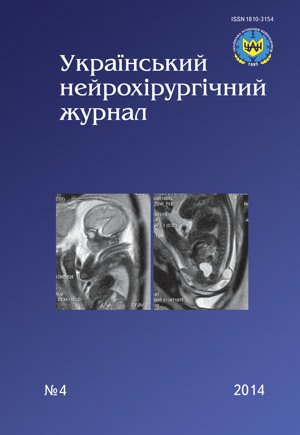Steroid epidural injections in treatment of radicular syndrome caused by degenerative-dystrophic diseases of the spine
DOI:
https://doi.org/10.25305/unj.46603Keywords:
degenerative-dystrophic diseases, radicular syndrome, epidural steroid injectionsAbstract
Introduction. The high frequency of degenerative-dystrophic diseases of the shine has necessitated introduction into clinical practice of effective method for steroids epidural injection for the treatment of radicular syndrome caused by degenerative spine.
The purpose. To improve efficacy of treatment of patients with radicular syndrome caused by degenerative diseases of the spine, through scientifically based definition of indications for steroids epidural injection.
Materials and methods. Early and remote results of 76 patients treatment with radicular syndrome (study group), aged from 38 to 82, using only epidural injections of steroids were analyzed. In the control group there were 30 patients, aged 42 to 79 years, they have been treated conservatively.
Results. Significant difference of early and remote results of treatment in two groups of patients was found according to Oswestry Disability Index and Visual Analog Pain Scale.
Conclusions. The high efficacy of epidural injections of steroids was shown in treatment of radicular syndrome caused by degenerative-dystrophic diseases of the spine. Epidural injections of steroids are indicated at intervertebral disks herniation (diameter up to 9 mm), spine canal stenosis, spondylolistheses, spondylarthroses that cause radicular syndrome.
References
Cunningham L, Kelsey J. Epidemiology of musculoskeletal impairments and associated disability. Am J Public Health. 1984;74(6):574-579. CrossRef
Podchufarova E, Yakhno N. Boly v spyne y konechnostyakh. Bolezny nervnoy systemy: rukovodstvo dlya vrachey. Moscow: Medytsyna; 2005. Russian.
Solokha O, Alekseev B. Lechenye boly v spyne: obozrenye knyhy R.U. Portera. Nevrol. zhurn. 1996;2:46–53. Russian.
Mixter W, Barr J. Rupture of the Intervertebral Disc with Involvement of the Spinal Canal. New England Journal of Medicine. 1934;211(5):210-215. CrossRef
McCarron R, Wimpee M, Hudkins P, Laros G. The Inflammatory Effect of Nucleus Pulposus. Spine. 1987;12(8):760-764. CrossRef
Hrynberh M. Neyrokhyrurhyya; per. s anhl. Moscow: MEDpress-ynform, 2010. Russian.
Stambough J, Templin C, Collins J. Case Report. Subarachnoid Drainage of an Established or Chronic Pseudomeningocele. Journal of Spinal Disorders. 2000;13(1):39-41. PubMed
Kondrashov OA. [Epidural steroid introduction in treatment of lumbar spine discoenic pain syndrome] [dissertation]. Kiev (Ukraine): Romodanov Neurosurgery Institute; 2012.
Radchenko V.A. Lechebnyye blokady s ispol'zovaniyem kortikosteroidov pri distroficheski-destruktivnykh zabolevaniyakh poyasnichnogo otdela pozvonochnika. Orthopedics, Traumatology and Prosthetics. 2000;3:116–120. Russian.
Spaccarelli K. Lumbar and Caudal Epidural Corticosteroid Injections. Mayo Clinic Proceedings. 1996;71(2):169-178. CrossRef
Hayes, Inc. Medical Technology Directory. Epidural Steroid Injections for Low Back Pain and Sciatica. Lansdale, PA: Hayes, Inc. 2013.
Benny B, Azari P. The efficacy of lumbosacral transforaminal epidural steroid injections: a comprehensive literature review. J Back Musculoskelet Rehabil. 2011;24(2):67-76. CrossRef
Cohen S, Bicket M, Jamison D, Wilkinson I, Rathmell J. Epidural Steroids. Regional Anesthesia and Pain Medicine. 2013;38(3):175-200. CrossRef
Cohen S, Mao J, Vu T et al. Does Pain Score in Response to a Standardized Subcutaneous Local Anesthetic Injection Predict Epidural Steroid Injection Outcomes in Patients with Lumbosacral Radiculopathy? A Prospective Correlational Study. Pain Med. 2013;14(3):327-335. CrossRef
Manchikanti L, Buenaventura RM, Manchikanti KN et al. Effectiveness of therapeutic lumbar transforaminal epidural steroid injections in managing lumbar spinal pain. Pain Physician. 2012;15(3):199-245. PubMed
Downloads
Published
How to Cite
Issue
Section
License
Copyright (c) 2014 Mykola Kvasnitskyi, Oleksandr Kvasnitskyi

This work is licensed under a Creative Commons Attribution 4.0 International License.
Ukrainian Neurosurgical Journal abides by the CREATIVE COMMONS copyright rights and permissions for open access journals.
Authors, who are published in this Journal, agree to the following conditions:
1. The authors reserve the right to authorship of the work and pass the first publication right of this work to the Journal under the terms of Creative Commons Attribution License, which allows others to freely distribute the published research with the obligatory reference to the authors of the original work and the first publication of the work in this Journal.
2. The authors have the right to conclude separate supplement agreements that relate to non-exclusive work distribution in the form of which it has been published by the Journal (for example, to upload the work to the online storage of the Journal or publish it as part of a monograph), provided that the reference to the first publication of the work in this Journal is included.









